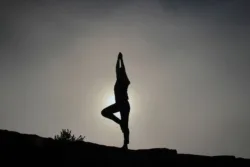
Yoga is a decades old practice, but only was recently welcomed into the field of addiction treatment as a beneficial and effective means of increasing mindfulness, relaxation and self-esteem, as well as decreasing chronic pain naturally.
What is therapeutic yoga?
Yoga is derived from the Sanskrit word yuj meaning “to join,” “to yoke” or “to unite.” This definition is fitting, seeing as yoga is all about connecting one’s mind, body and spirit through breathing and movement. This focus on the inhale and exhale, combined with the body’s flowing from one pose to the next, keeps you grounded, focused and relaxed in the present moment.
Yoga has proven so beneficial for so many in that it “is now regarded in the Western world as a holistic approach to health and is classified by the National Institutes of Health as a form of Complementary and Alternative Medicine (CAM).”
Benefits of therapeutic yoga for addiction recovery
Addiction plagues individuals with the inability to enter into the present moment, as well as co-occurring mental health disorders, physical pain and overall low self-esteem and confidence. Yoga, when combined with other counseling techniques, can benefit someone battling a substance use disorder by combating these challenges and boosting the success of recovery.
Increasing Mindfulness
Mindfulness can help you enter into the present moment, but it also benefits those recovering from addiction in countless other ways, including:
- Learning to control your breathing in a way that coincides with physical movement;
- Asking that when you step on your mat your focus remains there – this can help minimize frantic thoughts about anything else;
- Soothing pain through recognizing its presence and then letting it go;
- Giving control over your desires – becoming mindful gives you the strength to make choices that benefit your health and wellbeing and consequently refuse to commit self-harming actions.
Sounds very similar to the benefits of yoga, doesn’t it? This is why mindfulness and yoga go hand-in-hand in effectively minimizing the negative effects of addiction. They compliment each other in their focus on the importance of breathing to keep you centered and present in the moment, which in turn provides you with mental and physical peace and wellbeing.
Reducing Chronic Pain
Chronic pain can be incredibly debilitating, and many are disinclined to turn to prescription painkillers because of the possibility for addiction. While there are numerous holistic methods to reduce chronic pain, including acupuncture and physical therapy, yoga continues to be one method with promising results.
Yoga, in addition to a mindfulness practice, is very much a physical practice. No matter what kind of practice you choose to attend – such as a more aerobic vinyasa flow, or less intense gentle yoga – you work on strengthening and stretching the body.
Yoga also focuses on stamina, though not in “How long and far can I push myself,” kind of stamina. Stamina in yoga is more like the length of time you can hold a pose as guided by your breathing. And even if you’re a beginner, you might find this to be a very long time.
This slow, steady and highly intentional movement of the muscles is one of the key factors in reducing pain. By stretching out the tense muscles and strengthening the adjacent parts of the body, you can effectively prevent injury from overcompensation, giving some much needed relaxation to tired muscles.
Increasing relaxation
When your muscles and mind are relaxed, it’s not hard to believe that everything else will automatically feel relaxed and rested. This is one of the key benefits of yoga. Stretching, blended with intentional movement as guided by the inhale and exhale of breath, can’t do anything but release tension.
One study worded it perfectly: “Yoga encourages one to relax, slow the breath and focus on the present, shifting the balance from the sympathetic nervous system and the flight-or-fight response to the parasympathetic system and the relaxation response. The latter is calming and restorative; it lowers breathing and heart rate, decreases blood pressure, lowers cortisol levels, and increases blood flow to the intestines and vital organs.”
Boosting self-esteem
Through yoga’s practice, you learn to control your thoughts and subsequent emotions; you can take an active hand in lessening symptoms of depression and anxiety; and you can increase your physical health all at the same time.
Knowing you’ve made this choice for the sake of your mental and physical health is incredibly empowering. Seeing the physical results of routine yoga practice is also encouraging, adding to that growing sense of confidence and self-worth.
Plus, yoga is all about acceptance – so if you struggle to maintain down dog or can’t imagine ever holding a half moon pose, it doesn’t matter. So long as you’re there, breathing, remaining present and allowing your body to do its thing, you’re doing it correctly. And that is an incredible boost for one’s confidence.
Yoga in addition to addiction therapy
The benefits of therapeutic yoga are more than just physical – they increase mental clarity and help individuals remain rooted in the present. This is incredibly beneficial for clients battling addiction, and for anyone looking to improve their mental and physical wellbeing.
If you’re interested in incorporating yoga in your treatment plan, contact High Focus Centers PA today at 610-644-6464.




